Erice is a charming medieval village located on top of the namesake mountain.
From its 751 meters of altitude, it offers breathtaking views of the city of Trapani and the salt pans along the coast.
In the past, the mountain was known as San Giuliano and was home to a renowned sanctuary dedicated to the Goddess of fertility and protector of sailors.
This deity was known as Astarte to the Phoenicians, Aphrodite to the Greeks, and Venus Ericina to the Romans.
If you’re in search of a leisurely and authentic travel experience, Erice is the perfect destination.
Take your time to explore the narrow cobblestone streets, stopping to appreciate the open-air museum that is the village.
Be sure to schedule some relaxation time as well, perhaps with a leisurely stroll through the gardens or a cup of coffee at a local café.
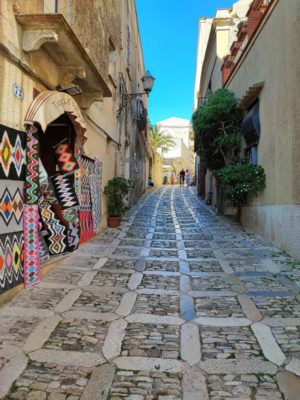
An alley in the historic center
Erice is an enchanting village that we highly recommend visiting during your trip to Sicily.
In fact, we enjoyed it so much that we visited it twice, on two beautiful sunny days in mid-May during our trip to the western portion of Sicily that included also the excursion to the beautiful Levanzo island.
However, it’s worth noting that the weather in Erice can be unpredictable, and the village is sometimes enveloped in a cloak of fog, which only adds to its mysterious charm.
Visit Erice with our complete itinerary for an optimal experience; learn about the must-visit sights and practical information to plan your visit to this beautiful destination.
Our flexible guide caters to your personal interests and takes into account the time you have available, making your visit to Erice stress-free and enjoyable.
Table of Contents
Making your way to Erice
Erice is easy to reach by car, either from Trapani via the SP31 or from Valderice.
Both routes offer stunning views of the surrounding landscape as they wind their way up the mountain.
If you don’t have your own means of transportation, then we recommend renting one, like we did.
As always, we relied on DiscoverCars.
It is a price comparison website between various companies, easily consultable online.
For us, it’s a guarantee.
Alternatively, you can take the Funierice, a cable car that departs from Trapani and takes just 10 minutes to reach Erice.
The cable car station is located a short distance from Porta Trapani, one of the main entrances to the village.
If you prefer to drive, you can park your car in one of the designated areas under the walls near Porta Trapani or along Viale Conte Pepoli.
For more information on schedules and fares, we recommend visiting the Funierice website.
Take a guided tour of Erice
For an effortless and fully immersive experience, we recommend taking part in a guided tour from Trapani.
This way, you can enjoy a complete and well-organized guided excursion to Erice without having to worry about the logistics.
The activity lasts about three hours and a half and the specialized guide speaks English.
Reached Erice by bus, you will embark on a walking itinerary that leads to the discovery of the most interesting places of the village.
During the walk there are stops to visit craft shops and to taste typical local products.
The excursion ends with the views from the balconies of the Spanish Quarter and Pepoli Castle, before returning to base.

Sicilian ceramics
Visit Erice: the must-see sights
Based on our personal experience, we recommend setting aside at least half a day to explore Erice. However, if you have more time available, we suggest extending your visit until late in the evening.
Keep in mind that temperatures can drop significantly in the evening, especially if it’s windy, so it’s a good idea to bring a sweater or sweatshirt with you.
In our opinion, the best time to visit Erice is in the afternoon, when the sunlight casts warm and vibrant hues on the village’s buildings.
When planning your visit, be sure to check the opening hours of the main churches, as they usually close before sunset.
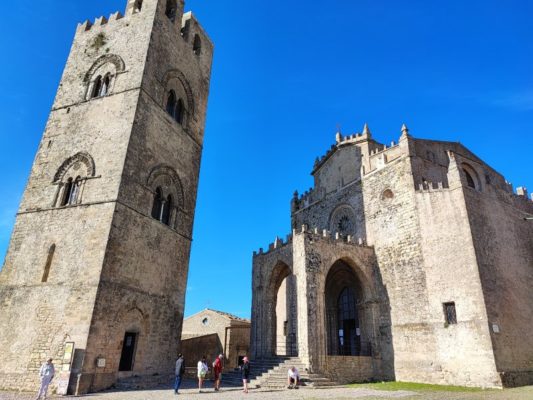
The Mother Church and the Bell Tower
The buildings in the village are made of gray stone, giving it a somber and monochromatic appearance.
Fortunately, the artisan shops display traditional ceramic sculptures and fringes, as well as brightly colored rag rugs, bringing joy to those who pass by.
We recommend taking a circular route through the village, starting and ending at Porta Trapani.
This route will take some time to complete and allows you to visit the most important landmarks in Erice.
If you plan to visit multiple monuments, consider purchasing the passe-partout ticket, which offers discounted access to several attractions.
Trapani Gate
Located within the walls of the Elimo-Punic era, Porta Trapani is one of the three main gates to the city, along with Porta Spada and Porta del Carmine.
Its name comes from its facing towards the city of Trapani, and it is a great starting point for exploring Erice.
The gate is a well-preserved example of ancient military architecture, and its strategic position made it an important defensive point for the city.

Trapani Gate
The medieval charm of this village is evident in the well-preserved walls, featuring quadrangular towers, particularly on the northwest side.
As you enter through the main door, you’ll find yourself on Corso Vittorio Emanuele, the bustling main street of the village.
The iconic Mother Church
As you continue walking just a short distance past Porta Trapani, you’ll arrive at a small square featuring the Mother Church, dedicated to the Assumption of the Virgin, and its towering bell tower.
Legend has it that the church was originally constructed in the 4th century AD under the Roman Emperor Constantine.
The current Gothic-style building, however, dates back to 1314 and was commissioned by Frederick III of Aragon using materials from the temple of Venus Ericina.
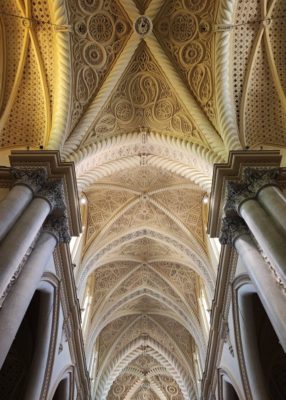
Ceiling of the Mother Church
The pronaos, or porch, of the Mother Church was added a century later to provide a space for penitents seeking atonement for their grave sins.
Tragically, the church suffered a collapse in 1853, leading to its interior being renovated in a neo-Gothic style in the 19th century.
Visitors can admire several artistic works inside the church, including a marble icon by Giuliano Mancino on the main altar and beautifully crafted stucco work on the ceiling.
The 28-meter-tall bell tower, originally built as a watchtower during the Sicilian Vespers war in the 13th century, can be accessed by climbing 108 steps to the top.
SS Salvatore Monastery
As you continue down Corso Vittorio Emanuele, you’ll come across the remains of the ancient Monastery of the Holy Savior, which was built on top of a series of ancient cisterns.
Originally the palace of the Chiaromonte family, the monastery was home to Benedictine nuns from the late 1200s.
Over the centuries, the monastery flourished due to its production of silk, gold, silver, coral wallpapers, and confectionery products. However, an 1866 law suppressing religious orders and confiscating their assets led to the decline of the monastery.
Sweet treats at Pastry Maria Grammatico
If you’re in need of a break during your visit to Erice, be sure to stop by Maria Grammatico’s pastry shop.
Over the years, this local bakery has gained a reputation as the best pastry shop in Sicily, attracting tourists from all over.
As you admire the delicious treats on display in the windows, consider taking a seat in the charming garden located at the back of the shop.
You’ll have a tough time deciding between the variety of traditional Sicilian sweets on offer, such as cannoli filled with ricotta, green cassata with almonds, sugar, vanilla, and ricotta, Martorana fruit, and Genoese cake.

Sicilian cassata and Marsala wine
Genovesi are a specialty of Erice, made from shortcrust pastry filled with custard and dusted with icing sugar.
The story of their creator, Mrs. Maria, is quite remarkable. Growing up in a large family, she was sent to the San Carlo orphanage after losing her father at the age of 11.
It was there that she learned the art of pastry making from the nuns.
When she turned 22, Maria left the institute and began making sweets to earn a living.
After indulging in these delicious treats, you can continue your journey through Erice and discover more of the town’s sights.
Piazza della Loggia, featuring the Town Hall and several rooms, is a must-see, and we recommend taking a stroll through the maze of alleys to reach the castle.
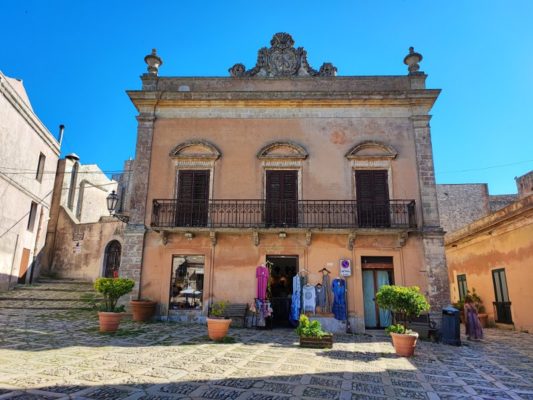
Piazza della Loggia
Bailo Garden and Venus Castle
Bailo is a stunning 19th-century English garden that spans multiple levels and is located at the eastern end of the village on the site of the ancient acropolis.
Nearby stands the Pepoli Castle, with its crenellated towers, which served as the seat of the governor of the village.
The Norman building was renovated in the latter half of the 19th century.
Perched on a secluded cliff of the acropolis is the Castle of Venus, built between the 12th and 13th centuries.
The castle contains the remains of the temple of Venus Ericina, a sacred well, a Roman spa building, and a Punic house.
From the castle, you can enjoy breathtaking views of the Trapani region on one side and the Gulf of Bonagia on the other.
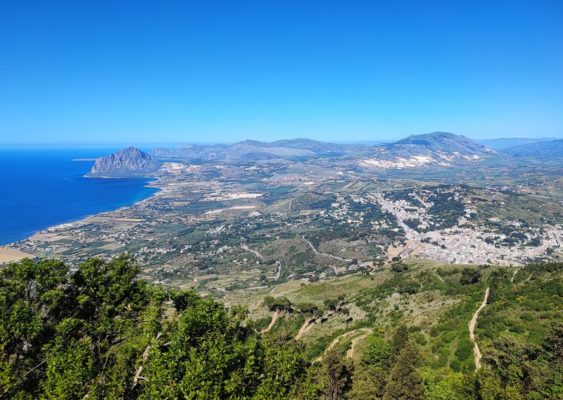
Panorama of the Gulf of Bonagia
The beauty of the Church of San Giuliano
A short walk from the castle brings you to the Church of San Giuliano, which is situated on a slight hill above street level.
Legend has it that the church was built in 1076 by Great Count Roger the Norman, but it is actually believed to date back to the early centuries of Christianity.
One of the first religious buildings in Erice, it was dedicated to Saint Giuliano, whom the Normans credited with their victory over the Arabs.
Since then, Saint Giuliano has also become the protector of the community.
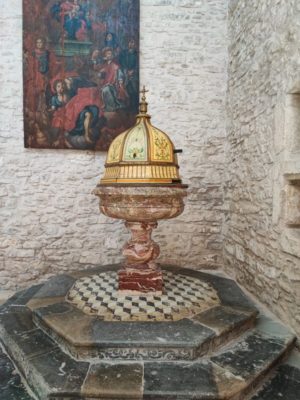
Baptismal font in the Church of San Giuliano
The Church of San Giuliano was rebuilt and expanded in the early 17th century and underwent further renovations after the collapse of the central nave in the 20th century.
Inside, you’ll find the Mysteries, a series of intricately crafted statuary groups depicting the final hours of Jesus’ life and showcasing the skilled craftsmanship of the Trapani region.
The baroque bell tower was added in 1770.
The frescoes of the Church of San Martino
As you leave the sacristy of the Church of San Giuliano, take Via Albertina Degli Abbati and in just a few hundred meters you’ll come across the Church of San Martino, easily identifiable by its pink-painted facade.
The church dates back to 1339, but has undergone significant structural and architectural changes over the centuries.
In 1682, it was completely rebuilt and expanded. Between the late 18th and early 19th centuries, the church was decorated with stuccoes and frescoes by the Manno brothers.
Next to the church is the meeting room of the Confraternity, which houses valuable wooden works from the 16th and 17th centuries.
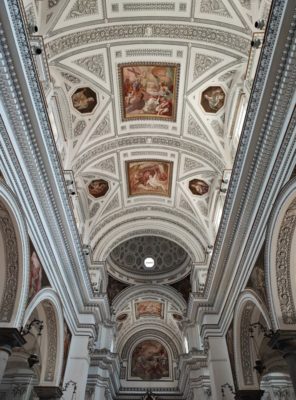
The ceiling of the Church of San Martino
Our one-day itinerary to discover the top sights in Erice ends with a visit to the Church of San Martino.
If you have extra time on your hands, we recommend adding a visit to the Church of San Pietro to your walk.
Located on one of the busiest streets in the village, the church is surrounded by souvenir shops, pastry shops, and restaurants.
At the northern end of Erice, you’ll find the Spanish Quarter, which was temporarily closed during our visit.



0 Comments